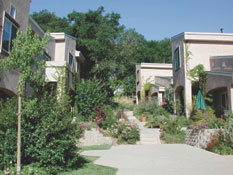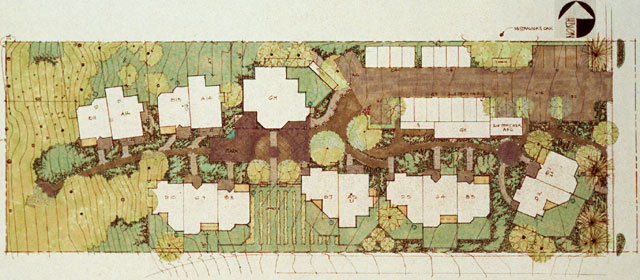Think about the people that you know and ask yourself how many of them fit into the “single family” model of chosen lifestyle. Perhaps you know an elderly person who doesn’t want the responsibility of maintaining a big home and would rather live with other folks in a similar situation. Maybe you know someone who doesn’t want to be married, but does want to live “in a relationship” with other people. How about a young person just starting out on her own, who is ready for some independence, but is not ready to take on homemaking on her own? What about a several generational family that wants to be close to each other, but not necessarily live in the same house?
In general, the zoning for developing residences across much of the United States is classified as “single family”; only one family may reside on any given lot. So what is a single family in the United States at the beginning of the 21 st Century?” The definition of what constitutes a family has gotten rather vague.
I sense a yearning among many people to experience life at home in a more communal way; they want to be able to share their lives more intimately with friends or like-minded people. They want to be able to share some facilities, and not be responsible for every aspect of a house unto themselves. They want to be able to find and afford their own place, which may not necessarily be a large house.
I feel that it would be much better to recognize and accept the great diversity of people around us, and actually provide homes for all of us, legally. This would mean making available small rental units, mother-in-law apartments, co-housing projects, cluster housing projects, multi-unit dwellings, along with the single family homes. Embrace the diversity!
This would not only be good for people, but it would also be good for our environment in that sharing facilities and leaving more open space is a more sustainable approach to living. Less redundancy means more efficiency in energy and materials used.
 Co-housing is a particularly interesting concept, in that it provides for the needs of individuals or small family units, while at the same time giving them access to each other as a close-knit community. A typical co-housing project will have space for six or more living units which are private from each other, and then there will be common space to be shared. This shared space might include a large kitchen and dining hall, a recreation or meeting room, meditation or spiritual room, laundry facilities, and workshop or garage space. There are many forms that such a community could take, and this form is under the control of those who organize it. Usually members own their particular quarters, and have shared rights for the use of the common space.
Co-housing is a particularly interesting concept, in that it provides for the needs of individuals or small family units, while at the same time giving them access to each other as a close-knit community. A typical co-housing project will have space for six or more living units which are private from each other, and then there will be common space to be shared. This shared space might include a large kitchen and dining hall, a recreation or meeting room, meditation or spiritual room, laundry facilities, and workshop or garage space. There are many forms that such a community could take, and this form is under the control of those who organize it. Usually members own their particular quarters, and have shared rights for the use of the common space.
Cluster housing is a little different, but has some similar attributes. Basically the idea is to cluster several houses within a relatively small area, leaving a substantially larger area undeveloped as open space. This gives the residents the opportunity to share their lives and facilities in some ways, like co-housing projects, while maintaining greater autonomy. This also affords the preservation of more open space than would happen with the same number of houses occupying lots in a conventional way.
Many folks express their concerns about allowing more than one “unit” on a lot. Some think increased traffic would be a problem; others feel that greater density would not pay for itself, in terms of maintaining the infrastructure. Someone might ask, “What about all of the lot owners who bought their lots knowing they were zoned for single families, and then years later discover an apartment next door?” I feel that these are all valid concerns that need to be addressed.

I think it is possible to have denser development without compromising open space. One approach to keeping density in check would be to require co-housing projects to acquire as much land as would be needed for a comparable number of single family units. Cluster housing typically creates more open space than would be left if the same land were developed as a series of single units. Likewise, there could be minimum lot sizes for allowing other forms of multi-unit development. Doing this would also equalize the potential for greater traffic.
How do you fit into our social equation? Why not make space for all of us to live to our fullest potential within housing arrangements that allow for the marvelous multiplicity of our personalities?

Zoning needs to go the way of the dinosaur!
YES~Nurturing Neighborhoods, where we all live nearby one another yet have our own spaces. built to be disaster resistant, fire resistant and more.
thank you, Kelly, for sharing what is in many folks’ hearts and minds. we are on the way to fulfilling many dreams.
Hi Kelly, thank you for putting so well into words all that is in my heart and mind.
As we move into the new chapter of earth adventures, all the old patterns and ‘rules’ of divide and conquer are done. even if they appeared to work in the past, this is no longer the case.
There are many souls who are dreaming these dreams of living closer, yet having our own spaces. living in nurturing neighborhoods.
more to come. as I find words to share.
And also share together while working out that many of us move about. Hold on to the basic base while being in and out. As a group we work this out. This is part of your thought that single family idea needs to be greatly blown open
Thanks for putting this out
I really like the concept of communal living. In northern Ghana, houses tend to be quite large as Ghanaian families are large and new structures – though modern in layout – are designed for the tradition of always hosting guests and family members, or with the expectation that there may be several members of the nuclear or extended family staying for prolonged periods of time.
Because of this, as a foreigner that rents, I often end up in houses that are far too large for mine and my daughter’s needs, so we rent our additional bedrooms out for some extra cash and the welcome company. It’s been quite a good arrangement as I typically invite only those that I’ve come to know through social circles to stay with us and I know from earlier interactions that we’ll get along well. Though this type of living in the blog post is a bit more separated, consistently having roommates and sharing a more communal style of living appeals to me.
I plan to start work on my property in November/December and plan to take this concept into my design. I’d like to have several free-standing bungalows, but with open spaces in the compound (half-acre) to set up shared spaces, such as a pavilion and picnic area, maybe a concrete pad in a shaded area for yoga or other types of exercise (even building an outdoor exercise space) – all for people to come and enjoy together as they rent out the bungalows for however long they need to. Coming to live and work in a foreign country, particularly on short-term assignments, can be isolating as you don’t have time to make the social connections. I think creating a communal space like the one I have described above and what we see in the blog would be a welcome shift to a more tightly-knit neighborhood type of space, as opposed to only seeing one another out in bars or at work events.
I also hope to cater to Ghanaians with this as well, especially those that may be based in the capital, but come up north for short stints of work. I think they may find this type of living welcome as well because culturally, most Ghanaians are very social and enjoy being out with friends and simply existing in a more communal way.